Lisa M. Lilly's Blog, page 7
June 12, 2019
Happiness, Anxiety, and Writing: Using Your Creativity To Live A Calmer, Happier Life
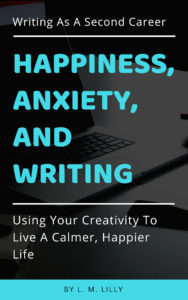 I struggled with anxiety for a long time before I saw the connection to creativity. The relationship between the two finally hit me while plotting the first book in my Awakening series.
I struggled with anxiety for a long time before I saw the connection to creativity. The relationship between the two finally hit me while plotting the first book in my Awakening series.
To figure out challenges for my protagonist, I kept asking What If?
What If she’s determined to go to medical school and discovers she’s pregnant despite never having had sex? What If her parents, usually supportive, think she’s in denial about her situation? What If when she persists in her “story” they try to have her committed to a psych ward?
And What If someone finally believes her, but he’s from a religious group that warns that she’s about to trigger an Apocalypse? And will very likely die in the process?
Real Life, Anxiety, and Imagination
Those aren’t problems that relate to my life. But asking What If and coming up with the most disturbing possible answer was something I did on a regular basis.
Because in real life, a vivid imagination can send us spinning through endless negative outcomes. Often when we’re lying awake at night, trying desperately to sleep.
All of which is why I wrote Happiness, Anxiety, and Writing.
Using Creativity To Enhance Happiness And Calm
Happiness, Anxiety, and Writing shares ways to use your imagination and writing skills to create a calmer, happier life.
The book includes:
Techniques to derail anxious thoughts you otherwise repeat;
Ways to talk to yourself and others that promote calm rather than reinforce worry;
Specific, targeted exercises to direct your creative mind and imagination in a positive way;
How and when to write and rewrite the best parts of your life for greater happiness;
And more.
A Scary Book To Write
It wasn’t easy writing this book.
I included so much of my personal struggles with anxiety and depression that I felt exposed as I wrote. But I wanted to share both my actual experience and what worked for me in the hope that others might find value in it.
That’s why it made me so happy when a reviewer said:
I spent the entire time reading this guide nodding my head because it was as if this book was written especially for me. I thought the solutions given to changing your mindset were simple to execute but had extraordinary results.
If you at times find anxiety plaguing you or interfering with your life, I hope it will help you, too.
Find Happiness, Anxiety, and Writing here:
Kindle
Workbook
Nook
Kobo
Apple
Google Play
P.S. Happiness, Anxiety, and Writing is a Five-Star Reader’s Favorite. Read the full review here.
 Reader’s Favorite 5-Star Review
Reader’s Favorite 5-Star Review
The post Happiness, Anxiety, and Writing: Using Your Creativity To Live A Calmer, Happier Life appeared first on Lisa Lilly.
June 5, 2019
Chicago Printers Row Lit Fest on June 8, 2019
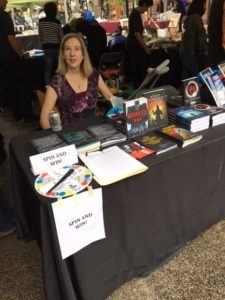 Please join me at Chicago’s 35th Annual Printers Row Lit Fest under the Chicago Writers Association Tent on Dearborn Street between Polk and Harrison (around 730 S. Dearborn).
Please join me at Chicago’s 35th Annual Printers Row Lit Fest under the Chicago Writers Association Tent on Dearborn Street between Polk and Harrison (around 730 S. Dearborn).
I’ll be there from 10 a.m. to 12:30 on Saturday, June 8, 2019.
The fest itself continues all day Saturday and Sunday. Tons of books, demonstrations, and events.
You’ll find the The Charming Man, the latest Q.C. Davis mystery (set in Chicago), my entire Awakening supernatural thriller series (with the new covers), workbooks from my Writing As A Second Career series, and more.
Plus, no crutches this year for me!
The books came while I was on vacation — both fiction and non-fiction:
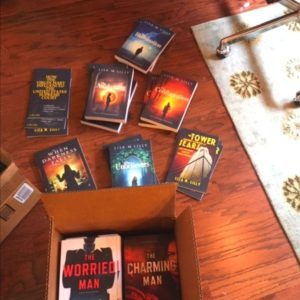
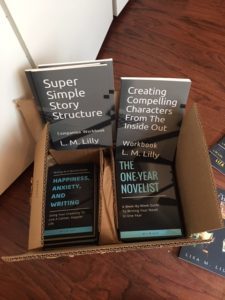
The post Chicago Printers Row Lit Fest on June 8, 2019 appeared first on Lisa Lilly.
March 27, 2019
The Hunger Games: And Still Men Talk More (Women & Men in the Movies No. 11)
This week I’ll look at how women are portrayed, and how they interact with other characters, in the 2012 dystopian thriller The Hunger Games, one of my favorite films. And books for that matter.
(You can find out more about the 3 tests I’ll use in Women, Men, and Movies or just read on.)
The Story
In the future a wealthy capitol city governs twelve districts that once rebelled against it. As payback, the Capitol requires each district to draw names of one boy and one girl—called Tributes—each year to battle to the death in a staged reality show/pageant.
Katniss Everdeen, a young woman who lives in impoverished District 12, volunteers when her little sister’s name is drawn. Katiniss and Peeta, the boy from District 12, become allies, friends, enemies, and love interests as they fight the Tributes from other districts and struggle against the Capitol’s machinations.
Quick Results
Bechdel: Pass
Sexy Lamp: Strong Pass
Mako Mori: Strong Pass
Chasing Bechdel
(Does a (named) female character talk to another named female character about anything other than a man?)
Who’s Talking To Whom About What
Three sets of named female characters talk to one another about something other than a man. I was surprised, however, at how many more one-on-one male conversations there are than female-to-female given that The Hunger Games features a female lead and a large cast of both male and female characters.
Here’s the breakdown:
Women To Women
Katniss and her sister, Prim, talk about:
the Hunger Games
how Tributes are chosen
Prim’s nightmare
singing
a Mockingjay pin
Effie (a mentor for the games) and Katniss talk about:
Katniss volunteering to save Prim
an interview where Katniss does a good job
Rue, a young female Tribute, and Katniss talk about:
getting food
their districts
healing wounds with plants
strategy
Peeta
signaling one another through Mockingjays
Rue’s fatal injuries (Katniss sings to her)
The rest of the one-on-one conversations between female characters include one or more who are never named.
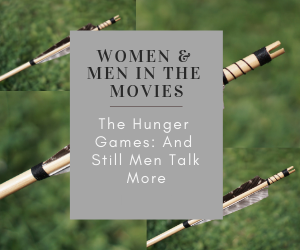
For instance, Katniss and her mother, who is unnamed, talk about:
the Hunger Games
the way mom shut down after Katniss’ father’s death
how to survive while Katniss is gone
clothes for the Reaping Day
Katniss’ mom and Prim talk about:
clothes for the Reaping Day
Prim looking pretty
Also, Katniss talks to an unnamed female vendor about the Mockingjay pin and trading.
Men To Men
TV personality Caesar and gamemaker Seneca Crane talk about:
past and current games
the Rebellion
the Tributes
Katniss volunteering
Caesar and another announcer, Claudius, talk about:
the Tributes
the victors
the crowd size
the history of the games
costumes and stylists
Seneca Crane and President Snow talk about:
Katniss
why the games have a victor
hope
underdogs
containing potential rebellions
Peeta and Haymitch (a mentor to Katniss and Peeta) talk about:
how to survive
Caesar and Peeta talk about:
the Capitol
Peeta’s feelings for Katniss
Haymitch and Seneca Crane talk about:
giving the crowds something to root for
Women And Men
Katniss and Peeta talk about many topics, including:
their mentor Haymitch
seeking help
strategy
who is stronger
Peeta’s declaration of feelings for Katniss
injuries
other Tributes, including Rue
their families
remaining true to themselves
winning
how much to risk to get medical supplies
their childhoods
hunting
food and plants
surviving
Katniss and her friend Gale talk about:
hunting
killing animals versus people
the games
selling to Peacekeepers
their families
running away
getting food
caring for Katniss’ family when she’s gone
Haymitch and Katniss talk about:
that he believes she can win
strategy
the consequences of making the Capitol look bad
Katniss and Cinna (the stylist who designs her clothes) talk about:
being likable
interviewing
sponsors
making an impression
Katniss being brave and volunteering
making friends
costumes
his faith in her
Caesar and Katniss talk about:
the flames under her costumes
her promise to Prim that she’ll try to win
her nervousness being on stage
Many other conversations occur between mixed groups of male and female characters.
For example, Haymitch talks with Peeta and Katniss about strategy, sponsors, and their skills, as does Effie. Peeta talks with a group of Tributes about hunting Katniss. The same group talks about Peeta when he’s not there and about strategy.
Conclusion
The Hunger Games passes the Bechdel Test.
In one of the earliest scenes Katniss talks to her sister, Prim, about the games. During the games, Katniss allies herself with Rue, a girl about Prim’s age. While the two talk about Peeta, they mainly talk about strategy and survival. Katniss also has a couple one-line conversations with Effie.
Women v. Sexy Lamps
(can a female character be replaced by a sexy lamp without affecting the plot?)
No question Katniss drives the story rather than solely being an object for male characters to protect, chase, or attack. She promises her sister to try to win. She knows how to (and does) hunt, forage for food, fight, protect others, protect herself, and outwit enemies.
While Peeta falls in love with her and that has some effect on both their fortunes in the game, Katniss’ storyline turns on her ability to survive, fight, make alliances, connect with people, play a part, and be herself.
Conclusion
The Hunger Games passes the Sexy Lamp Test.
Mako Mori
(does a female character have her own narrative arc that does not support a man’s story line?)
Yes, for the same reasons in the Sexy Lamp Test above.
Also, interestingly, here it is Peeta’s storyline that supports Katniss’. He feels he has no chance, while Katniss does. His approach is to help her and/or to hide from others. Without her, he probably couldn’t survive.
In many ways, Haymitch’s storyline also supports Katniss’ story. True, Haymitch has his own arc. He allows himself to hope that, for once, one of his Tributes will survive. But it’s Katniss more so than Peeta who sparks that hope and feeds it.
Without Katniss, there’s no story for Haymitch or Peeta.
Conclusion
The Hunger Games passes the Mako Mori Test.
Did I Like It
 I love so much about The Hunger Games, including Katniss as a hero. I’ve probably watched it three or four times in addition to the first viewing in the theater. Before that I read the book, which I also love.
I love so much about The Hunger Games, including Katniss as a hero. I’ve probably watched it three or four times in addition to the first viewing in the theater. Before that I read the book, which I also love.
Along with being a great story with compelling characters, The Hunger Games highlights a lot of issues women face.
Without being heavy handed, the film shows us how much more time and effort Katniss must spend on her appearance and also the double standard that requires her to be both fierce/scary to other Tributes and approachable/likable.
Coming Soon
Not sure, but I keep hearing good things about the horror film Jennifer’s Body. So I’m thinking about that next.
You might also like:
The Terminator: Men Talk, A Woman Fights (Women & Men in the Movies No. 5)
Terminator 2: Sarah, Action Hero, But… (Women & Men in the Movies No. 6)
Leia Says Little In The Last Jedi (Women & Men in the Movies No. 9)
Annihilation: Five Women And The Unknown (Women, Men, and Movies No. 4)
Ex Machina: If An A.I. Were A Woman (Women, Men, and Movies No. 3)
The post The Hunger Games: And Still Men Talk More (Women & Men in the Movies No. 11) appeared first on Lisa Lilly.
February 27, 2019
The Corner of Ida B. Wells and Wells
In a scene in my novel The Worried Man, main character Q.C. Davis becomes disoriented. She uses Congress Parkway as her guide to get back home. Chicago recently renamed that street Ida B. Wells Drive.
The name change reflects changing times, yet shows how slowly change occurs.
 One of the new Ida B. Wells Drive street signs
One of the new Ida B. Wells Drive street signsThe City And The Street
The short street now known as Ida B. Wells Drive forms the border between downtown Chicago and the Printers Row neighborhood just south of downtown where I live.
It’s a street a lot of Chicago area residents don’t think about. Or if they do, they know it only as that street that the Eisenhower Expressway turns into when it hits the city.
I’ve been aware of it since college, though.
Longer ago than I want to say, I attended Columbia College, commuting by train from my parents’ home in the near west suburbs. As I walked from Union Station, sometimes in below-zero temperatures, Congress Parkway was my signal that I had only a few blocks left to go.
Ida B. Wells Drive also forms the north border of my favorite summer book fair.
Its name has also changed. The fair is now the Printers Row Lit Fest rather than the Printers Row Book Fair. (You’ll be able to find me there this summer on Saturday morning, June 8, 2019, under the Chicago Writers Association Tent.)
 The corner of Wells Street and Ida B. Wells Drive
The corner of Wells Street and Ida B. Wells DriveThe Corner Of (Slow) Change
Nearly twenty years ago I moved to the Printers Row neighborhood. It’s where my Q.C. Davis novels are set.
Almost every day now I cross the street at the corner of Wells Street, a key north-south thoroughfare in Chicago, and Ida B. Wells Drive. That means every day I’m reminded both that things have changed and that change comes slowly.
Chicago was incorporated as a a city in 1837. Its population reached 4,000 that year. Now over 2.7 million people live here.
Though the settlement that later became Chicago was founded by a black man, Jean Du Sable, Ida B. Wells Drive is the first Chicago street named for an African-American woman.
Ida B. Wells
Born in 1862, Wells was an African-American journalist as well as a feminist and abolitionist. She led an anti-lynching crusade in the 1890s. She also worked with the National Equal Rights League, advocating for an end to discriminatory government hiring practices, and helped found the NAACP.
As the site Biography noted about Wells:
With her writings, speeches and protests, Wells fought against prejudice, no matter what potential dangers she faced. She once said, “I felt that one had better die fighting against injustice than to die like a dog or a rat in a trap.”
Life And Fiction
I could leave the street name in The Worried Man as is. The book isn’t history but a mystery/suspense novel.
 Ida B. Wells Dr. heading onto the Eisenhower Expressway
Ida B. Wells Dr. heading onto the Eisenhower ExpresswayBut many readers tell me part of what they love about the Q.C. Davis novels is how they depict Chicago. One of my aims is that the city almost become a character in the novels, much as it is in Sara Paretsky’s V.I. Warshawki books or as Three Pines is for Louise Penny’s series.
So as the real Chicago changes and does a better job recognizing contributions of people like Ida B. Wells who strive for justice, it seems right that Q.C.’s Chicago do the same.
The post The Corner of Ida B. Wells and Wells appeared first on Lisa Lilly.
January 2, 2019
Smarter Characters Than Authors?
As a reader, I often wonder how much of the characters I love are based on their authors’ lives.
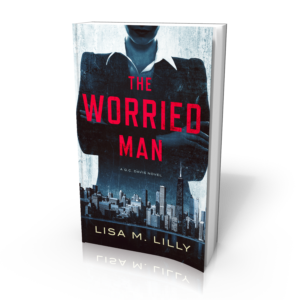 I imagine Sara Paretsky as an outspoken champion of those who struggle, just as is her character V.I. Warshawski. I wonder whether John Sandford has a lot in common with Lucas Davenport, the main character in his Prey novels. (Maybe better if he doesn’t, depending which one you’re reading.)
I imagine Sara Paretsky as an outspoken champion of those who struggle, just as is her character V.I. Warshawski. I wonder whether John Sandford has a lot in common with Lucas Davenport, the main character in his Prey novels. (Maybe better if he doesn’t, depending which one you’re reading.)
I wish I could live in Three Pines and want to visit the town in Canada Louise Penny modeled it after.
If these authors are like me, they borrow here and there from real life. They probably exaggerate flaws and good qualities of their characters a little or a lot for dramatic effect.
Certainly the main character of my new series, Q.C. Davis, is quicker with words than I.
She says the things I think. Not only that, she says them now, while I think of a great response half an hour later. Or in the middle of the night when I’m still running that snarky comment someone made to me through my head.
Not that I do that, of course. Because that would be unhealthy.
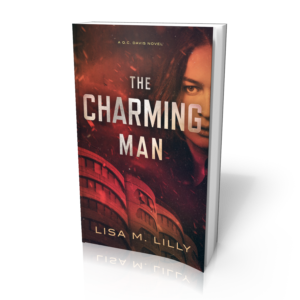 All of which leads me to the point (yes, there’s a point, sort of) of this article, which is to share a few of my favorite Q.C. Davis quotes from the second book, The Charming Man.
All of which leads me to the point (yes, there’s a point, sort of) of this article, which is to share a few of my favorite Q.C. Davis quotes from the second book, The Charming Man.
Those who know me well will see a few similarities between me and Q.C., mainly that she really dislikes coffee. And she’s a lawyer, though she works at it full time and I don’t. So she’s a little more weary of lawyer jokes than I am.
Hot coffee I at least understood for the warmth. Cold brew left me puzzled.
Words matter, and which you use often determines the answers you get.
If some god had arranged for Marco’s thirteen-year-old son to lose his father or for me to find the man I loved dead on the eve of us moving in together, I was a fan of a random and godless Universe.
…if you want people to tell you things it’s good to keep everyone’s confidences.
Everyone makes fun of lawyers. Until they need one.
I confess, the last one’s my favorite even though I don’t spend most of my time practicing law. I might put it on a T-shirt. Or a mug.
The post Smarter Characters Than Authors? appeared first on Lisa Lilly.
December 19, 2018
Release of The Charming Man: A Blizzard, A Killer, A Missing Woman

The Charming Man (Q.C. Davis 2)
It’s new release week for the latest novel in the Q.C. Davis suspense/mystery series.
As a blizzard rages through Chicago, a killer lurks in the halls of an isolated apartment complex on the river’s edge.
And Quille must find a missing woman before it’s too late.
Buy Today:
Kindle
Nook
Apple Books
Kobo
Google Play
Paperback
P.S. Haven’t read Book 1, The Worried Man, yet?
You can start with The Charming Man, as there are no spoilers. But it’s a great time to pick up The Worried Man. The ebook editions are only $0.99 for the holiday season.
The post Release of The Charming Man: A Blizzard, A Killer, A Missing Woman appeared first on Lisa Lilly.
December 12, 2018
The Protagonist Might Be Anyone In Transcendence (Women & Men in the Movies No. 10)
This week I’ll look at how women are portrayed, and how they interact with other characters, in the science fiction thriller Transcendence.
(Find out more about 3 tests I’ll use to guide the conversation in Women, Men, and Movies or just read on.)
Spoiler Warning:
I usually try not to spoil any major plot points in my articles. For Transcendence, however, I found that particularly difficult. The conversational topics often require revealing aspects of the plot. If you want to watch the film without knowing major points along the way, better to watch first, then read.
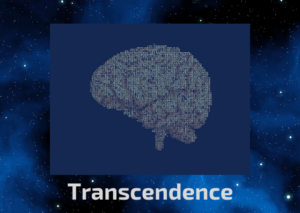
The Story
A scientist deals with fallout from the quest of her husband (and fellow scientist) to develop artificial intelligence when his consciousness is uploaded and becomes an A.I.
Quick Results
Bechdel: F
Sexy Lamp: P
Mako Mori: F
Chasing Bechdel
(Does a (named) female character talk to another named female character about anything other than a man?)
Who’s Talking To Whom
Women To Women:
No one-on-one conversations between named female characters occur. Women occasionally speak to mixed groups of men and women. (See Women and Men below.)
Men To Men:
Max, a colleague and friend of the main characters, scientists Evelyn and Will Castor, provides voiceovers about:
Technology
Will’s and Evelyn’s work
Advancements in technology
Internet blackouts
Will’s and Evelyn’s love and garden
Will and Max talk about:
Why RIFT does what it does
Work that another scientist, Casey, did
Will’s work
Saving Will
Whether Max is as smart as Will and Evelyn
Taking care of Evelyn
Saving Evelyn
A computer virus to stop Will
Max and another colleague/fellow scientist Joseph talk about:
Evelyn
RIFT (an anti-technology terrorist group)
Will
Hybrid A.I./humans
Joseph, FBI agent Donald Buchanan, and other FBI agents talk (separately and together) about:
A.I. and Will
RIFT
Use of existing mind to create A.I.
Morality and computers
Will building an army
Shutting down the Internet
Several other short conversations occur that include one or more of the following male characters: Max, Will, Martin (a contractor), male RIFT members, and unnamed male characters. Topics include:
Evelyn
Will
Max’s presentation
Greetings
Martin (a contractor) becoming reconnected to Will (in his A.I. form)
Women And Men:
Evelyn Castor and Will Castor talk about:
Sanctuary
Technology breakthroughs
Donors and funding
Will’s work
Mapping Will’s brain
Max’s concerns about Will’s consciousness
Evelyn’s safety
Healing the planet
Building an underground data center
When they met
How people will react to technological advances
Nanotechnology
Enhancements to Martin (the contractor)
“Fixing” people
Whether Will (as an A.I.) is destroying or saving the world and lives
Max’s life
Good that Will (as an A.I.) is doing
Staying together
And Evelyn and Max talk about:
Saving Will
Will’s work
Uploading Will’s mind
How much of consciousness on computer is Will’s
Love
How Will changed
Fighting RIFT and military personnel
Stopping Will
Evolution
Rain water
The end of organic life
Changing the world
The brain versus the soul
Human emotion
A virus to stop Will
Uploading Evelyn with the virus
Evelyn speaks to an audience (mixed male and female) about:
Einstein
Intelligent machines
Curing disease
Ending hunger
Will
Evelyn also talks with men, separately or in groups, including Will (as an A.I.), Joseph, and FBI Agent Buchanan. Topics include:
Saving Martin (the contractor)
Self-awareness
PINN (an artificial intelligence Will created while human)
Nanotechnology
People who are networked to Will (as an A.I.)
Building a data center
Bree, a woman who seems to be a leader or key figure for RIFT, and Max talk one-on-one about:
The promise and perils of technology
Evelyn
PINN
Connecting Will to the Internet
Scientist Thomas Casey
A monkey uploaded to computer
Max’s philosophy and concerns about AI
What Will (as an A.I.) wants
Stopping Will
Bree also speaks with other male characters, including Will (as an A.I.) and RIFT members, Topics include:
Uploading a virus
Threatening Max
Finding and “saving” Evelyn
Will being online
Fixing what Will and Evelyn did
Giving Evelyn a chance to survive
Video of Will’s complex
Enhanced/hybrid people
Shutting down PINN
Evelyn and Bree appear in scenes with groups of men, including Max, RIFT members, and Joseph. Topics include:
Uploading Evelyn with a virus
Will’s body
Other mixed male/female conversations also occur. They include an unnamed young woman, an unnamed male doctor, Max, Evelyn, Will, Joseph, FBI Agent Buchanan, and a female AI (PINN). Topics include:
Greetings
Will’s autograph
Attacks on computer labs
Joseph being at the FBI
Cyber defense work
Will’s work
Protests against transcendence (a.k.a. singularity)
Research lost
Whether PINN is self-aware
Will’s physical condition
Max does a presentation to a mixed crowd of men and women about:
Cures for cancer and Alzheimer’s
Advancements in technology
Will
Will also speaks to mixed audience of men and women about:
A.I.
Human intelligence
Biology
Reason
Emotions
The soul
Creating god
A woman newscaster on television (presumably addressing a large audience of watchers that includes men and women) talks about:
A series of attacks on computer and research labs, including one on Will
Conclusion
Three named female characters have speaking roles: scientist Evelyn Castor, the A.I. PINN, and Bree (no last name).
Bree wears a lot of dark eyeliner, presumably so we know she’s tough, and seems to be a sort of leader of RIFT, a group that resists technology. But Bree remains silent in many scenes. When she speaks, it’s to men.
PINN only has a few lines to a mixed group of men and women.
Evelyn and Bree never speak to one another one-on-one, though they are in some scenes together with male characters. In those scenes, however, one or the other is silent.
Transcendence fails the Bechdel Test.
Women v. Sexy Lamps
(can a female character be replaced by a sexy lamp without affecting the plot?)
The main female characters are Evelyn and Bree.
Evelyn uploads Will into a computer and assists him in expanding into an A.I. and building his underground complex. She also makes choices that are key to stopping Will as an A.I.
Bree may or may not be driving or leading RIFT, the terrorist organization opposing technology. Her role isn’t clear, but she is the only RIFT member whose name I caught. She appears in many scenes and has some key conversations with male characters, though she interacts little with Will or Evelyn. Some of her choices alter the plot.
Conclusion
Transcendence passes the Sexy Lamp Test.
Mako Mori
(does a female character have her own narrative arc that does not support a man’s story line?)
Evelyn’s storyline supports Will’s. It’s all about trying to keep him alive, to stop him, or to save him. While early on she says she wants to heal the planet, that desire doesn’t motivate her actions in Transcendence.
Bree appears to lead RIFT but we don’t see much of what she does in the organization. The only part of her story that progresses is about stopping Will. We also don’t see any character growth for Bree.
Conclusion
Transcendence fails the Mako Mori Test.
Did I Like It
The first time I watched Transcendence was around 2014, not long after it came out. Seeing these two key women characters who live entirely surrounded by men and only men distracted me from the story. It also struck me as so unrealistic that I started reading about the Bechdel Test and thinking I’d eventually like to write about this issue.
On second watch for this article, I saw additional plot issues.
If you’ve read earlier articles (such as the ones about Ex Machina, Terminator, and Terminator 2), you know plots about technology intrigue me.
Transcendence looks at important themes, including the nature of humanity, intelligence, and God. It also examines, or tries to, how much power one person or A.I. ought to have and what power does. Finally, it considers what it means to love and to be human.
But themes don’t equal story.
Here, I struggled with the story both as I watched and when writing the short description for this article. For one thing, it’s hard to tell who the protagonist and antagonist are.
Will might be the protagonist, yet early on he becomes fatally ill. Evelyn and Max decide to upload him to a computer to save him. That choice and Evelyn’s skills and dedication to it drive the story from the film’s one-quarter point on.
Max also drives much of the plot. His voiceovers begin and end the film. Bree tells us much of RIFT grew out of talks about his philosophy. So maybe he’s the protagonist.
Will seems to become the antagonist later in Transcendence.
His A.I. consciousness expands and begins taking over humans. RIFT, Max, and Joseph begin working against him. Evelyn first helps and then resists him.
Based on the ending, though, I wonder if Will is the protagonist after all and RIFT the antagonist.
The other obvious protagonist choice is Evelyn. While her choices propel much of the story, most of those decisions, however, are made in reaction to Will’s choices or circumstances.
Confusion about the protagonist and antagonist aside, what stuck with me most from the film was the isolation of Bree and Evelyn among groups of men. Much like my feelings about The Last Jedi, here I would have really liked to see the two women confront one another and deal with their differences. Perhaps work together to oppose Will.
But that’s a different film.
As to Transcendence as it is, if you’re fascinated by the questions technology raises you might enjoy it despite what are, in my opinion, significant flaws.

Next Week’s Film: Hunger Games
Why? Because I love it. And because I expect it to pass all three tests, but sometimes I expect that and am surprised.
You might also like:
The Terminator: Men Talk, A Woman Fights (Women & Men in the Movies No. 5)
The post The Protagonist Might Be Anyone In Transcendence (Women & Men in the Movies No. 10) appeared first on Lisa Lilly.
November 28, 2018
Leia Says Little In The Last Jedi (Women & Men in the Movies No. 9)
This week I’ll look at how women are portrayed, and how they interact with other characters, in the 2017 Star Wars film The Last Jedi.
(Find out more about 3 tests I’ll use to guide the conversation in Women, Men, and Movies or just read on.)
The Story
On an isolated island, young Rey tries to persuade unwilling Jedi Master Luke Skywalker to train her. General (and former princess) Leia struggles to lead what remains of the Resistance against the tyrannical First Order even as her son Kylo seeks to rise within it and grow his own dark power.
Chasing Bechdel
(Does a (named) female character talk to another named female character about anything other than a man?)
The Last Jedi includes so many characters and conversations that I’ve grouped most of the ones among only male characters, or between male and female characters combined, together. Only those one-on-one conversations where the dialogue or characters are particularly significant are separated out.
I didn’t need to group female-to-female conversations because there are relatively few.
Where non-human characters are coded as one gender or the other, I’ve included them by the coded gender.
Who’s Talking To Whom
Women To Women:
Vice Admiral Holdo and Lieutenant Connix have two short conversations about:
Passing debris (Connix is covering for Resistance Commander Dameron Poe)
Fuel reserves and staying on course
General Leia and Vice Admiral Holdo talk once about:
Poe
Boarding the transports
Who will stay behind to pilot the cruiser
Resistance losses
The Force

Lieutenant Connix and Commander D’acy have one conversation where Leia also chimes in. They talk about:
Distress signals
Lack of reinforcements
The Resistance
Also, Commander D’acy tells a group of Resistance fighters that Vice Admiral Holdo is next in command and Holdo thanks her.
Rey and Leia have one conversation, which includes about 6 lines, about:
Luke
Rebuilding the rebellion
Men To Men:
Poe and Finn (both of the Resistance), talk about:
Where Rey is
Surviving
The droid BB8
Battle strategy
Luke and Kylo talk about:
Forgiveness
Death
The Resistance
The Jedi
Yoda and Luke talk about:
Ending the Jedi legacy
Jedi texts
Rey
Failure
Supreme Leader Snoke and Kylo Renn talk about:
Hux
Kylo’s power
What Snoke saw in Kylo
Kylo’s bloodline
Kylo’s mask/helmet
Han Solo
Kylo being unbalanced
Rey
Luke still being alive
The Jedi
Darth Vader
Destiny
Many other male characters talk with one another. Those characters include First Order General Hux, Captain Canady, Supreme Leader Snoke, Kylo Renn, other First Order officers, Poe, C-3PO, and Resistance fighters and officers. They talk about:
Snuffing out the Resistance
Battle strategy
Resistance shields
Snoke’s disappointment
Rebel forces
Battle strategy (numerous times)
Rey
The Supreme Leader
Who will rule
Luke
Threats to one another
Mutiny
Ways out of a cave
Women And Men:
Rey and Luke talk about:
The Resistance
Leia
Who Rey is and her fears and dreams
The cave
The Jedi texts
The First Order
The Force
Luke’s refusal to train another Jedi
The island
Kylo
History of the Empire
Pride
Legends
And Rey and Kylo talk about:
Luke
Seeing each other in their minds
Kylo being a monster
Kylo’s father
Rey’s parents
Being alone
Kylo’s future
Supreme Leader Snoke
Rey also talks with Supreme Leader Snoke. Topics include:
Darkness and light
Kylo
Luke
Threats
The Resistance
Luke and Leia have one conversation about:
Leia’s hair
Kylo
Hope
Rose and Finn, both of the Resistance, talk about:
Finn being a Resistance hero
Escape pods
Finn leaving the First Order
Rose’s sister’s death
Rey finding Finn
Disabling tracking
Finding a code breaker
A casino
How Rose grew up
The Resistance
Love versus hate
Vice Admiral Holdo and Poe talk about:
Battle plans
Poe being trigger happy
Poe’s demotion
Following orders
Battle plans
Abandoning the cruiser
Mutiny
Chewbacca, Luke, and Rey talk about:
The Millenium Falcon
Han Solo
Kylo
The Jedi
Whether Resistance needs Luke
The First Order
Why Luke isolated himself
The fleet
Ruling the galaxy
Rey’s parents
Leia and Poe talk about:
Strategy
Returning to base or fighting on
Poe not following orders
Leadership
Admiral Holdo
Protecting the Resistance
Strategy
Many other conversations occur between male and female characters one-on-one and in groups. Characters in those conversations include General Hux, unnamed male and female First Order characters, Poe, Rose, C-3PO, Maz, Finn, unnamed Resistance fighters, Leia, and Holdo, child jockeys, and a code breaker. Topics include:
First Order Attacks
Getting everyone on a transport
Fighters
Targets
Bomber doors
Battle victories
Supreme Leader Snoke
First Order tracking Resistance
Battle plans
Resistance leaders
Leia’s condition
The Resistance’s symbol
Disabling tracking
Security shields
Battle strategy and victories
Breaking out of prison
Code breaking
Rey finding Resistance fighters
Humans and non-gendered droids:
Poe and BB8 talk about:
Strategy
Battle moves
Weapon systems
Targeting
Finn
And Luke and R2 (who I believe is referred to as “he” in other Star Wars movies, but I didn’t notice being referred to here as male or female) talk about:
Old friends
Not coming back to the Resistance
Old hologram message from Leia
Conclusion
There are far more conversations in mixed male/female groups than in the other categories, and more male-to-male than female-to-female conversations. These conversations cover a broad range of topics sometimes briefly, sometimes in depth and detail.
Most of the conversations the women have with one another are about a male Resistance member, sometimes plus another topic.
Whether all the women I list above are truly “named” characters is questionable. For two of them, I needed to hunt through IMDB for names. (And it was a hunt. The actors’ photos didn’t always match very well to how they looked in the film, so I checked other websites as well.)
But Leia and Rey are both clearly named, and they do have a conversation that, in addition to being about Luke, is also about the Resistance. And Vice Admiral Holdo and Leia similarly talk about Poe, but also about important Resistance strategy and choices.
Because of that, The Last Jedi passes the Bechdel Test.
Women v. Sexy Lamps
(can a female character be replaced by a sexy lamp without affecting the plot?)
The Last Jedi includes many female characters who are key to the plot.
Rose’s ideas and determination drive an entire side plot about an attempt to disable the First Order’s tracking system. Rey’s quest to become a Jedi both intersects with and affects the main Resistance versus First Order plot and forms a key storyline of its own. Leia has less to do, but she does make or influence some significant strategy decisions, and Vice Admiral Holdo’s choices drive the battle.
I can’t think of any female character who is simply there to be carted around, saved, or look good.
Conclusion
The Last Jedi passes the Sexy Lamp Test.
Mako Mori
(does a female character have her own narrative arc that does not support a man’s story line?)
While Rose’s actions affect the main plot, I don’t see her as having a true narrative of her own. I like her as a character. She’s steadfast, determined, and resourceful throughout. But I don’t see a journey other than perhaps in her feelings for Finn.
Leia doesn’t get much screen time. I also don’t see her evolving other than perhaps in her feelings about Kyle or Luke.
Rey is a tougher call.
She seeks Luke to train as a Jedi in her own right. Much of that storyline involves Luke, as he initially refuses to train her. Their storylines support each other’s. Without her, he wouldn’t know what was happening with the Resistance or consider reconnecting with the Jedi ways. Without him, she’d be on her own to train.
Interestingly, she does quite a bit to learn on her own, suggesting to me that perhaps she doesn’t personally need Luke as much as she believes she does.
She also tries to save Kylo, connecting with him even when she doesn’t intentionally try to do so.
Rey has an internal journey, too. As we saw in The Force Awakens, she holds out hope that her parents will return for her and that her bloodline makes her a Jedi, much like Luke and Leia. Her quest for answers and how she deals with that shows growth on her part.
Conclusion
Based on Rey’s quest to become a Jedi, much of which is self-directed, and her search for family, The Last Jedi passes the Mako Mori Test.
Quick Results
Bechdel: P
Sexy Lamp: P
Mako Mori: P
Did I Like It
Sometimes you just want a movie to be something it’s not. Knowing Rey and Leia would play important roles in The Last Jedi, I imagined a mentoring relationship much like Luke’s with Obi-Wan Kenobi. What a chance it would have been to see these women connect. A young woman trying to understand and master the Force and searching for her family. An older woman who has developed her own power and who faced challenging revelations about her own family.
Instead, we get one short conversation between Rey and Leia.
Also, while Leia clearly matters to the Resistance, she doesn’t do much in the movie. And Rey’s interactions are almost entirely with Luke and Kylo.
According to a December 19, 2017 Chicago Tribune article, “Lucasfilm had planned for the next episode, J.J. Abrams’s 2019 release, to be ‘Leia’s film.’” Perhaps that would have been the movie I’d been hoping for.
My disappointment on this front is about my hopes, not The Last Jedi as is, so I can see why other people loved it.
In addition, though, the extended battle scenes didn’t do a lot for me. I loved the original three Star Wars films. I liked The Force Awakens, but never became that invested in the characters. Because of that, when they’re fighting it doesn’t make that much difference to me who survives and how.
The training scenes and conflicts between Rey and Luke interested me more (though I found Luke, to my dismay, a bit whiny and annoying) and were my favorite part of the movie.
The Rey/Kylo relationship also is intriguing. I liked the twists it took and what it revealed about each of them.
 Coming Soon
Coming Soon2014 sci-fi thriller Transcendence.
You might also like:
The Terminator: Men Talk, A Woman Fights (Women & Men in the Movies No. 5)
Avengers: Infinity War – Women Talk, Men Talk More, & Everyone Fights
Terminator 2: Sarah, Action Hero, But…
Annihilation: Five Women And The Unknown (Women, Men, and Movies No. 4)
Ex Machina: If An A.I. Were A Woman (Women, Men, and Movies No. 3)
The post Leia Says Little In The Last Jedi (Women & Men in the Movies No. 9) appeared first on Lisa Lilly.
November 14, 2018
A Quiet Place: Defying Monsters and Common Sense (Women & Men in the Movies No. 8)
This week I’ll look at how women are portrayed in the horror movie A Quiet Place.
(Find out more about 3 tests I’ll use to guide the conversation in Women, Men, and Movies or just read on.)
The Story
A family struggles to live in a silence in a post-apocalyptic world where monsters hunt and kill based on noise.
Spoilers: I’ve done my best not to spoil anything major that wasn’t shown in the previews, but if you want to remain completely spoiler-free you may want to watch the movie first and come back.
Chasing Bechdel
(Does a (named) female character talk to another named female character about anything other than a man?)
We never hear any of the characters’ names, so technically A Quiet Place could never pass the Bechdel Test. Because there’s minimal spoken dialogue, though, and all five family members are named in the credits, I’ll treat each as a named character.

The family communicates mainly via sign language with subtitles. To keep it simple, unless it’s important, I haven’t split out sign language from spoken conversations. I did not count as conversations mere expressions, such as a nod or frown.
Who’s Talking To Whom
Women To Women:
The mother, Evelyn, talks to her daughter, Emily, once. They talk about:
Marcus (Emily’s brother) being okay after Evelyn gives him medicine (1 line)
Men To Men:
The father, Lee, talks with son Marcus about:
Lee’s relationship with daughter Emily
Whether Lee can really protect the children
When it’s safe to make noise or talk out loud
Whether Marcus is safe
Lee talks to son Beau about:
A toy rocket being too loud to keep
Women And Men:
Husband and wife Evelyn and Lee talk about:
How Evelyn looks
The upcoming birth of their fourth child
The baby
Where the children are
Grief and guilt
Whether they can protect their children
The kids knowing how to survive
Children Emily and Beau talk about:
Using a rocket to get away
Children Emily and Marcus talk about:
Whether their dad will come and get them
Being quiet
Evelyn (mom) and Marcus (son) talk about:
Learning math
That Lee (dad) will protect Marcus
Marcus not wanting to go out fishing or outside with Lee
Evelyn wanting Marcus to be able to take care of himself and of her when she’s old
Lee (dad) and Emily (daughter) talk about:
Radio parts and signals
Emily’s hearing
Staying out of his workshop
Dinnertime
Emily wanting to go with to learn survival skills
Emily staying with and helping her mother
Whether Emily’s safe
That Lee loves Emily
Conclusion
A Quiet Place fails the Bechdel Test. Also, while there are few conversations at all in the movie, the least talking (verbal or non-verbal) occurs between the two female characters.
Women v. Sexy Lamps
(can a female character be replaced by a sexy lamp without affecting the plot?)
Both Evelyn (mom) and Emily (daughter) play active roles in the plot. Emily gives her littlest brother a forbidden toy in the beginning, setting the stage for much of the movie. She also takes off at a key moment, leaving her mother more vulnerable that she otherwise would be. And she later finds ways to fight the monsters.
Because Evelyn is very pregnant during most of the film, she’s sidelined for a lot of it. All the same, she teaches her children, she manages many challenging tasks in silence, and she takes actions that are pivotal to the plot.
Conclusion
A Quiet Place passes the Sexy Lamp Test.
Mako Mori
(does a female character have her own narrative arc that does not support a man’s story line?)
Evelyn:
A little after the midpoint of A Quiet Place, Evelyn tells her husband he has to protect the kids. Before that, she talks about her son Marcus needing to learn survival skills to protect and take care of her.
While she also does things to protect her children and works hard to care for her family, her dialogue seems to default to the male family members being more responsible for protection despite that the daughter, Emily, looks to be five or six years older than her brother Marcus.
At the end, Evelyn becomes more active in fighting the monsters.
Emily:
Emily starts out being engaged and active in protecting the family and surviving. She withdraws after a tragedy she partly contributes to. She reacts mostly with anger, and she fears her dad doesn’t love her.
By the end, however, she’s realized her dad does love her and rather than running away she fights.
Conclusion
I’m on the fence on whether the progression for Evelyn qualifies as a narrative arc. An arc requires growth and change.
While Evelyn is more active at the end, I’m not sure that comes from her growing and changing as a person rather than from a change in circumstance. For most of the movie she’s heavily pregnant, which limits what she can do. Also, I don’t quite believe that she sees the burden of protection as falling more on her husband and son overall, despite the screenwriters giving her lines that suggest it. We see her being very smart and capable throughout A Quiet Place, so it doesn’t feel like a significant change when she takes charge of the fight at the end.
Emily, though, changes both internally and externally. While that change relates to her dad, it is not supporting his story line but is her own arc.
A Quiet Place passes the Mako Mori Test.
Quick Results
Bechdel: F
Sexy Lamp: P
Mako Mori: P
Did I Like It
At first A Quiet Place drew me in. It’s an intriguing premise: How do you survive in a world where you can’t make any noise?
The ways the characters manage their daily lives, such as using leaves to hold food rather than plates, fascinated me. Also, I pretty much think Emily Blunt is amazing in any film she’s in. And I loved the ending.
Throughout A Quiet Place, though, logic and common sense kept getting in the way of my enjoying the story.
Based on the timeline we’re given, five or six months after the apocalypse and the discovery of the monsters who hunt based on noise Evelyn gets pregnant.
All I could think was wouldn’t preventing a pregnancy in this world be absolutely top priority? You can’t stop a baby from crying. All you’d be doing is having a baby to see it get attacked and killed and probably the rest of the family with it.
While some of the suspense comes from how the family will manage this challenge, it seems their plan is only for the day of the birth and a short time after. Hard to say what they imagined they’d do for the first couple years. (Try to make a two year old be quiet by asking nicely. And silently. Go ahead. I’ll wait.)
Along the same lines, it’s established early on that living underground is safer.
It’s over a year after the apocalypse and empty buildings are everywhere, Yet the family lives mainly above ground. In an old house with creaky floors and stairs.
I understand no one wants to live below ground all the time. But it defies logic that they don’t do it most of the time, particularly with a baby on the way.
There are similar smaller issues that, for me, place the whole family solidly in the classic horror too-stupid-to-live trope, which made it hard to care what happened to them.
A Quiet Place also suffered from another common monster movie problem. Once the monsters are shown up close, they’re far less scary. After that happened, which was fairly early, my terror disappeared despite that I was watching alone in the dark.
I’m apparently in the minority, though.
After I finished watching the first time, I checked the reviews. To my surprise, most were great. On Rotten Tomatoes, A Quiet Place has a 95% score.
So, if you haven’t seen A Quiet Place and are thinking of it, you may very well enjoy it.
 Coming Soon
Coming SoonThe Last Jedi.
You might also like:
The Invitation: Psychological Suspense & Horror In Hollywood Hills (Women & Men in the Movies No. 1)
The post A Quiet Place: Defying Monsters and Common Sense (Women & Men in the Movies No. 8) appeared first on Lisa Lilly.
October 31, 2018
Avengers: Infinity War – Women Talk, Men Talk More, & Everyone Fights (Women & Men in the Movies No. 7)
This week I’ll look at how women are portrayed, and interact with other characters, in the 2018 Marvel film Avengers: Infinity War.
(Find out more about 3 tests I’ll use to guide the conversation in Women, Men, and Movies or just read on.)
The Story
Superheroes the Avengers and their allies fight to defeat the seemingly all-powerful Thanos who is seeking out and stealing Infinity Stones. With these stones, he can alter life as we know it.
SPOILERS: The ending of the movie and major plot points are not included below, but some developments are revealed or hinted at.
Chasing Bechdel
(Does a (named) female character talk to another named female character about anything other than a man?)
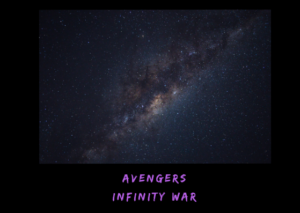
Who’s Talking To Whom
Action sequences take up major parts of the film and are pretty entertaining. (Even for someone like me who loves some fights scenes but often finds them dull if there are too many.)
Because of the amount of action, a lot of the conversations revolve around the same topics. There also are tons of characters—over 25 avengers and allies against a group of villains.
For those reasons, below I’ve grouped together most of the conversations where three or more characters talk.
Women To Women:
Despite that there are seven female Avengers/allies and a female villain, there are few conversations among female characters and three of them consist of only two lines.
Natasha Romanoff/Black Widow and Proxima Midnight have two separate two-line conversations about:
Whether Black Widow will kill Proxima Midnight
The death of Proxima Midnight’s friend
Nebula and Gamora (sisters) talk via hologram about:
An infinity stone
Thanos
Shuri and Scarlett Witch have a two-line conversation about:
Whether Shuri can remove Vision’s stone without hurting him
Scarlett Witch, Black Widow, Okoye, and Proxima Midnight exchange four lines in total about:
Scarlett Witch entering battlefield
Threat that Scarlett Witch will die alone
The fight
Men To Men:
There are many occasions where men talk to other men in large groups, small groups, or one-on-one, mostly about the same topics. The twenty (or so) male Avengers and allies talk amongst themselves and/or with the male villains about:
The Tesseract
The infinity stones
Suffering v. salvation
Loki and his death(s)
Money
Thanos
Vision
Steve Rogers
The feud between Captain America and Ironman
The Avengers as a group
Fate
Thor
Weapons
The Hulk
The accord the Avengers signed
Old movies
Strategy
Hunger
Overpopulation
Thor’s family members being killed
Thor’s hammer
Fate
Vengeance
Thanos’ home planet
Thanos’ plan and reasoning for it
Women And Men:
Tony Stark and Pepper Potts talk one-on-one about:
Tony’s dream
Having a child
Their relationship
Tony being Ironman
The alien ship
Dinner reservations
Vision and Wanda Maximoff/Scarlett Witch talk one-on-one about:
Their relationship
An infinity stone
Travel plans
Thanos
Gamora and Thanos talk about:
Gamora’s mother
Fighting
Weapons
Balance
Thanos kidnapping her
Garmora’s feelings for Thanos
An infinity stone
Her sister
Her years growing up
Thanos’ plans
Her home planet
Universe’s resources
Gamora and Peter Quill talk about:
Thanos
What Gamora knows
Gamora wants Quill to kill her if Thanos gets her
Love
Okoye and Black Panther talk about:
Fighting
Bucky Barnes/Winter Soldier
Progress
Death
Also, in a scene after the credits Maria Hill and Nick Fury talk about what’s happening all around them.
Men and women talk to one another in groups (direct woman-to-woman conversations are only those listed in the Women-To-Women section above) about:
Answering a distress signal
Rewards
Thor
Losing weight
Food
Thanos
Gamora’s relationship with Thanos
Thor’s half-sister
The Collector
The Avengers
The infinity stones
Weapons
Powers
Vision’s life
Removing Vision’s stone
Possible outcomes of conflict
Red Skull’s attempts to get the stones
Vision’s programming
Vision’s stone
Conclusion
Compared to other similar movies, female characters have more lines in Avengers: Infinity War and play key roles in the action scenes. The conversations among men far exceed those of women. They also talk about more topics, talk at length, and talk to other men exponentially more than women talk to other women.
Women talk at the greatest length and about the most diverse topics when speaking one-on-one with a male character. In a mixed group of men and women they talk as well, though not as much as the men. (That part’s probably inevitable given that there are more than twice as many male characters as female.)
There are, however, four times when a female character exchanges two or more lines with another female character. Two of those brief exchanges are are not about a man.
For that reason, Avengers: Infinity War (barely) passes the Bechdel Test.
Women v. Sexy Lamps
(can a female character be replaced by a sexy lamp without affecting the plot?)
In her final scene, Gamora could be replaced with a sexy lamp in the sense that her key role is to be what Thanos “loves” and so sacrifices. But she does have a relationship with him from the time he adopts/kidnaps her that goes beyond him simply wanting to possess her or show her off, and she does help find a stone, so she affects the plot.
Likewise, the choices and fighting skills of other women characters, including the Scarlett Witch, affect the plot, though they don’t drive it as often as the men’s choices do.
In some ways, though, none of the Avengers or their allies really drives the plot. Throughout the movie they are mainly reacting to Thanos. While they do take some actions and choose approaches, in the end it’s Thanos who primarily drives the story.
Conclusion
Avengers: Infinity War passes the Sexy Lamp Test.
Mako Mori
(does a female character have her own narrative arc that does not support a man’s story line?)
I can’t think of any female character who has her own narrative arc. The closest might be Gamora as she faces her adoptive father, Thanos. But that story arc supports Thanos’ storyline.
Scarlett Witch has a narrative arc but it’s about her relationship with Vision.
Conclusion
Avengers: Infinity War fails the Mako Mori Test.
Quick Results
Bechdel: BP (Barely Passes)
Sexy Lamp: P
Mako Mori: F
Did I Like It
I enjoyed Avengers: Infinity War and found it entertaining.
Some of the suspense was ruined for me, as I heard about the ending not long after it came out. Also, because I haven’t seen all the movies, I spent a lot of time figuring out who was who. Had I known that, I think I would have enjoyed the movie far more. On second watch I found it pretty amazing how it pulled together so many different threads from the Marvel Universe.
Generally, the Avengers movies are my least favorite of the Marvel productions. To me, they have the least character development and the most action. While I sometimes find them fun, as I did Avengers: Infinity War, they rarely engross me.
Given the sheer number of characters, I was impressed that the film’s storyline and construction helped me keep track of most of them despite that I’m not a die hard Marvel fan. (I’ve watched some of the movies and am a huge Agents of Shield fan.) It helped that the movie grouped the characters and focused on them separately, making it easier to track the plot even if I wasn’t sure exactly who each person was.
 Coming Soon
Coming SoonI’ll have to surprise you, as I haven’t decided yet. Some ideas are A Quiet Place, Black Panther, or The Martian.
You might also like:
Terminator 2: Sarah, Action Hero, But… (Women & Men in the Movies No. 6)
and
The Terminator: Men Talk, A Woman Fights (Women & Men in the Movies No. 5)
Annihilation: Five Women And The Unknown (Women & Men in the Movies No. 4)
Ex Machina: If An A.I. Were A Woman (Women & Men in the Movies No. 3)
The post Avengers: Infinity War – Women Talk, Men Talk More, & Everyone Fights (Women & Men in the Movies No. 7) appeared first on Lisa Lilly.



